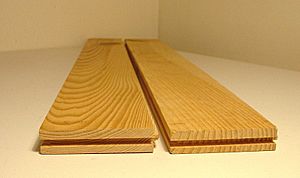Tongue and groove facts for kids
A tongue and groove joint is a clever way to fit two pieces of material, usually wood, together along their edges. Imagine one piece of wood having a "tongue" – a small, sticking-out ridge – and another piece having a "groove" – a matching slot. When you push them together, the tongue slides perfectly into the groove, creating a strong and flat connection. This method is super useful for things like wood flooring, wall panels, and even fancy parquetry designs. It helps pieces stay firmly joined and creates a smooth surface.
Contents
What is a Tongue and Groove Joint?
This special joint is made up of two parts. One part is called the tongue. It's a ridge that sticks out along the edge of a board. The other part is called the groove. This is a slot or channel cut into the edge of another board. The groove is made to fit the tongue perfectly.
How Does it Work?
When you want to join two boards, you simply slide the tongue of one board into the groove of the other. They fit together like puzzle pieces. This creates a very strong connection that holds the boards firmly in place. It also helps to keep the surface flat and even.
Where is Tongue and Groove Used?
Tongue and groove joints are very popular in building and woodworking. They are used in many places where you need to join flat pieces of wood together.
Flooring and Paneling
One of the most common uses for tongue and groove is in flooring. Each floorboard has a tongue on one side and a groove on the other. This allows them to lock together tightly across a room. This method is also used for wall panels and ceilings. It creates a smooth, continuous surface without gaps.
Other Uses
Before plywood became common, tongue and groove boards were also used for other purposes. They were used to build the wooden frames for pouring concrete, called "formwork." This showed how strong and reliable these joints were. Today, they are still a top choice for many woodworking projects.
Why is Tongue and Groove Useful?
This type of joint offers several benefits that make it a favorite among builders and woodworkers.
Strong and Stable
The main advantage is how strong and stable the joint is. When the tongue fits into the groove, it creates a large surface area for glue. This makes the connection very secure. It helps prevent boards from moving or separating over time.
Flat and Smooth Surfaces
Tongue and groove joints help create a flat and even surface. This is important for floors and walls, where you want a smooth finish. The interlocking design helps keep the boards aligned. This reduces the chances of bumps or gaps appearing.
Easy to Install
For many projects, tongue and groove boards are relatively easy to install. They simply slide into place, which can speed up construction. This makes them a good choice for both professional builders and people doing home projects.
See also
 In Spanish: Machihembrado para niños
In Spanish: Machihembrado para niños


